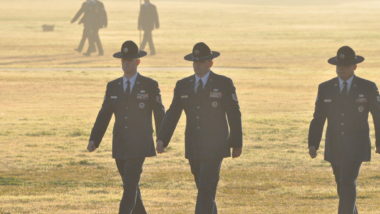Not sure of the best way, but here’s how I did it.
My book, Dreams of the Philippines: Escape from Clark Air Base, is fiction but based on a trip I took to the Philippines as a young air force lieutenant way back in 1989.
Here’s the promo video I made for the book. The pictures in the video are from 1989 during my adventure trip to Clark Air Base near Angeles City, island of Luzon, Philippines.
The challenge facing me as an author – how do I take the real life trip and create a story; a story worth telling? Here’s how I tackled this challenge.
My adventure to the Philippines back in 1989 didn’t have a compelling story line. OK, maybe it did, but I couldn’t find it. What it did have was a bunch of isolated stories. Stories I wanted to tell. Stories I felt were interesting. Stories I wanted to share with the world.
So, I began writing.
I’d write down one story, hit the save button and start writing the next one. I kept writing. That is, until I ran out of stories. Then I became stuck. Stuck like a bug on a fly strip. Stuck like a saber-tooth tiger in a tar pit. Stuck like a Long Island Expressway rush hour commuter. I wasn’t moving. Without a compelling story line, I was dead in the water.
My individual stories – perhaps interesting on their own – were not really connected. The only thing tying them together was chronology. So, essentially, when I was done, I had a glorified travel log – ‘I did this, I went there, I met so-and-so, I danced, I sang and then I went home.’ But I didn’t want to write a travel log. I wanted to write a story – a heartfelt story. In order to do that I needed a compelling story line. I didn’t have one. I went searching.
And, this represented new territory for me. How do you look for a story line … a compelling one? I had no idea. (I still don’t!) But, after thinking about it for a while … a long while … I decided to research the Philippines – specifically Clark Air Base. I started reading personal accounts from people stationed there. It was from one of these accounts that I got the idea for the central caper in this book. It’s something I never would have dreamed up – way too clever. The crime was pulled off in a mystifying way. They never caught the “geniuses” who did it. I decided this would be the crime for my story. I liked it because it’s clever but also because it’s based on something that really happened. So, when someone challenges, “That’s impossible, couldn’t happen.” I can confidently say, “… but it did.” Does the phrase, “Truth is stranger than fiction” mean anything to you?
Then – for reasons not entirely clear to me – I decided to center the story on one of my characters. My only criteria, it had to be a Filipino. I had several serious contenders but I finally settled on a young boy I met briefly on the streets of Angeles city way back in late March 1989.
Once I had these two main ingredients – a caper and a character – I began re-writing the story starting from the middle and working “outwards.” This approach gave me targets, it gave me focus, it allowed me to connect the stories, even if only loosely. Is that how you’re supposed to write stories? Don’t ask me. But, that’s how I went about fixing my “stuck” problem.
Now I was back to writing again. I had a destination. But, I still had a lurking problem. I’d say my problem was similar to military aircraft in-flight refueling … it’s easy to understand the general concept, but it takes skill to do it. The devil is in the details. I wouldn’t want somebody refueling my airplane who claims “I’m an expert!” because they read the manual once during a coffee break. It’s one thing to say, “In-flight aircraft refueling is easy, just connect the hose and start pumping jet fuel.” It’s another thing to be able to do it. It’s called experience, skills and know-how. And, it involves lots of – DETAILS!
Well, my lurking problem was how to connect my caper with my character. Yes, I had a general idea, but just like the coffee break in-flight aircraft refueling expert, I had no skills, no experience and no know-how. I’d never done it before. Even so, I didn’t let this obstacle stop me. I continued typing away believing I would eventually figure it out. I confidently moved forward with the project believing the answer would appear and my lurking problem would be solved.
And, where did I get this belief?
Glad you asked.
For me, the most difficult part of making the connection between caper and character was this … you’ve got to be creative.
I have a challenge with creative. But, luckily I could consult someone who’s proven over the years to be very creative. A man named Stephen King. I consulted Mr. King via his book, “On Writing.” I’d read it once before, but when I became stuck with this story, I read it again. Because I was in desperate need of a story line I got a lot more out of his book the second time through. I paid special attention to his advice on plot.
I was seeking a plot. I wanted something clever like an Agatha Christy who-done-it novel. But, my attempts at “clever” kept turning into “corny.” I stared getting bogged down. I started fearing the keyboard. Like before, I felt dead in the water, not moving, going under – drowning.
But, when I took Mr. King’s advice on plot, life got better. I started to get my nose and mouth above water, I could breathe again. Finally, I swam to shore, dried off and got back to the keyboard.
Mr. King’s advice on plot is essentially this … RELAX! Don’t get hung up on it. Let the story unfold on its own. According to Mr. King, the author’s job is to uncover the story that’s already there. Just keep writing and let the story come out. Keep asking, “What if?” questions and let the characters act out their roles. I accepted his advice and began letting the characters take me where they wanted to go. I didn’t fight it.
The story is written from the perspective of a young Air Force 2nd Lieutenant named Sean Mitchell. This character is based on me. I like using Sean in my fiction stories because it makes the writing a lot easier. All I have to do is explain everything from my perspective. I don’t have to be all-knowing. I just tell it how I see it.
This book involved some soul searching. While I generally try to keep things light if I can, this story exposes a challenging issue. Why pick a challenging issue? After all, fiction means I can write about whatever I want. Why not pick something upbeat? Why not pick something easygoing?
Here’s why – I boldly took Mr. King’s advice, “… stories … pretty much make themselves. The job of the writer is to give them a place to grow. Stories are found things, like fossils in the ground. Stories are relics, part of an undiscovered pre-existing world. The writer’s job is … to get as much of each one out of the ground intact as possible.”
So, that’s what I did. I started hunting for the story. I went searching and digging like a treasure hunter, like an archaeologist. The story you’re about to read is what I found, what I dug up. Hopefully, I got most of it out of the ground intact.
Note: This is an excerpt taken from the Preface of the book.
Image by Fathromi Ramdlon from Pixabay


